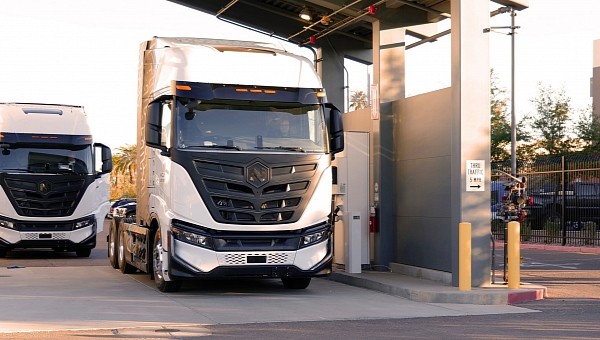The main criticism against fuel cells is that they are less energy-efficient than batteries. We could say it is the only one if it were not for hydrogen made from fossil fuels. Regardless of these critiques, current battery packs have a weight penalty that is difficult to dodge, and the time it takes to recharge them is also an issue. Nikola may solve that with fuel cell trucks and mobile hydrogen fuelers.
This is the third criticism FCEVs get: there is insufficient hydrogen refueling infrastructure in place, and improving it would not be worth it. Nikola begs to disagree and will turn its hydrogen tube trailers into mobile hydrogen refueling stations. Each of these trailers has the capacity to carry 960 kilograms of hydrogen at 700-bar (10,153-psi). Considering the tanks of each Nikola Tre FCEV get topped up with 100 kg of the gas, each mobile fueler can serve nine trucks.
Placed at strategic locations, they will help Nikola’s customers reach their destinations with green hydrogen – produced with renewable energy. Carey Mendes suggests these mobile fuelers will be a temporary solution. According to Nikola’s president of energy, this service “will be an integral part of Nikola’s flexible customer service in its early years.” That will be necessary while the company is building its “permanent hydrogen fueling stations.”
If the service is successful, we suspect it may extend for as long as Nikola establishes its hydrogen fueling network, especially on more relevant routes for the company’s clients. The Tre FCEV has a range of 500 miles, but it gets a full tank of hydrogen in much less time than Tesla promises to recover 70% of the Semi’s charge: less than seven minutes versus 30 minutes – at the very least.
Although the first mobile fueler has already been released for market operation, the company scheduled an official introduction to the solution for January 25. More units will hit the road in Q1 2023.
Nikola is also celebrating that it received a Zero-Emission Powertrain Executive Order from the California Air Resources Board (CARB). This certification is necessary for the Tre FCEV to be eligible for the Hybrid and Zero Emission Truck and Bus Voucher Incentive Project (HVIP). And that means a massive economy for Nikola’s clients.
According to Nikola, the HVIP can grant incentives of $240,000 per truck, a value that rises to $270,000 if the truck is used in drayage fleets. Fleets from disadvantaged community areas with less than ten trucks performing drayage operations can get up to $288,000 per truck.
Nikola did not say how much each Tre FCEV costs, but prices for brand-new Class 8 trucks go from $80,000 to $200,000. That gives us the impression that the Tre FCEV could be entirely paid by Californian taxpayers. Apart from the state incentives, the Tre FCEV also qualified for the $40,000 federal tax credit for trucks established by the Inflation Reduction Act (IRA).
Placed at strategic locations, they will help Nikola’s customers reach their destinations with green hydrogen – produced with renewable energy. Carey Mendes suggests these mobile fuelers will be a temporary solution. According to Nikola’s president of energy, this service “will be an integral part of Nikola’s flexible customer service in its early years.” That will be necessary while the company is building its “permanent hydrogen fueling stations.”
If the service is successful, we suspect it may extend for as long as Nikola establishes its hydrogen fueling network, especially on more relevant routes for the company’s clients. The Tre FCEV has a range of 500 miles, but it gets a full tank of hydrogen in much less time than Tesla promises to recover 70% of the Semi’s charge: less than seven minutes versus 30 minutes – at the very least.
Although the first mobile fueler has already been released for market operation, the company scheduled an official introduction to the solution for January 25. More units will hit the road in Q1 2023.
Nikola is also celebrating that it received a Zero-Emission Powertrain Executive Order from the California Air Resources Board (CARB). This certification is necessary for the Tre FCEV to be eligible for the Hybrid and Zero Emission Truck and Bus Voucher Incentive Project (HVIP). And that means a massive economy for Nikola’s clients.
According to Nikola, the HVIP can grant incentives of $240,000 per truck, a value that rises to $270,000 if the truck is used in drayage fleets. Fleets from disadvantaged community areas with less than ten trucks performing drayage operations can get up to $288,000 per truck.
Nikola did not say how much each Tre FCEV costs, but prices for brand-new Class 8 trucks go from $80,000 to $200,000. That gives us the impression that the Tre FCEV could be entirely paid by Californian taxpayers. Apart from the state incentives, the Tre FCEV also qualified for the $40,000 federal tax credit for trucks established by the Inflation Reduction Act (IRA).












